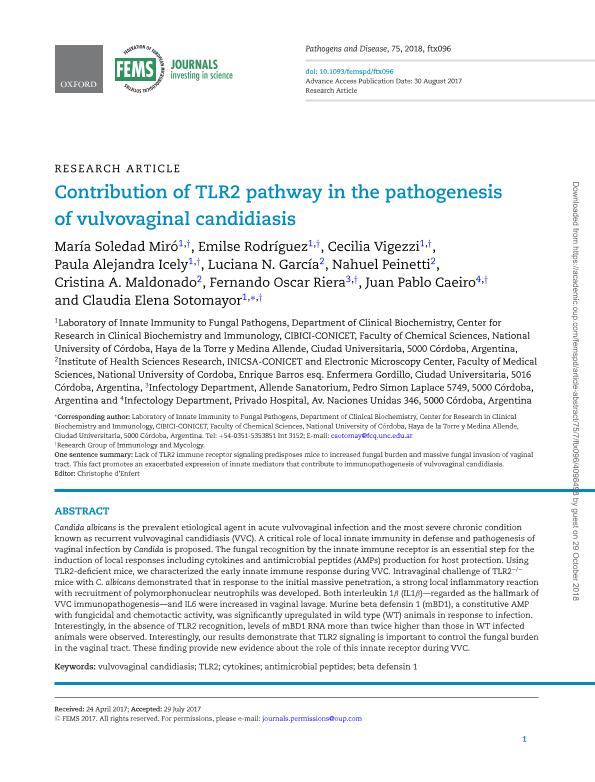Artículo
Contribution of TLR2 pathways in the pathogenesis of Vulvovaginal candidiasis
Miró, María Soledad ; Rodriguez, Emilse
; Rodriguez, Emilse ; Vigezzi, Cecilia
; Vigezzi, Cecilia ; Icely, Paula Alejandra
; Icely, Paula Alejandra ; García, Luciana Noemí
; García, Luciana Noemí ; Peinetti, Nahuel
; Peinetti, Nahuel ; Maldonado, Cristina Alicia
; Maldonado, Cristina Alicia ; Riera, Fernando Oscar; Caeiro, Juan Pablo; Sotomayor, Claudia Elena
; Riera, Fernando Oscar; Caeiro, Juan Pablo; Sotomayor, Claudia Elena
 ; Rodriguez, Emilse
; Rodriguez, Emilse ; Vigezzi, Cecilia
; Vigezzi, Cecilia ; Icely, Paula Alejandra
; Icely, Paula Alejandra ; García, Luciana Noemí
; García, Luciana Noemí ; Peinetti, Nahuel
; Peinetti, Nahuel ; Maldonado, Cristina Alicia
; Maldonado, Cristina Alicia ; Riera, Fernando Oscar; Caeiro, Juan Pablo; Sotomayor, Claudia Elena
; Riera, Fernando Oscar; Caeiro, Juan Pablo; Sotomayor, Claudia Elena
Fecha de publicación:
09/2017
Editorial:
Oxford University Press
Revista:
Pathogen and Disease
ISSN:
2049-632X
Idioma:
Inglés
Tipo de recurso:
Artículo publicado
Clasificación temática:
Resumen
Candida albicans is the prevalent etiological agent in acute vulvovaginal infection and the most severe chronic condition known as recurrent vulvovaginal candidiasis (VVC). A critical role of local innate immunity in defense and pathogenesis of vaginal infection by Candida is proposed. The fungal recognition by the innate immune receptor is an essential step for the induction of local responses including cytokines and antimicrobial peptides (AMPs) production for host protection. Using TLR2-deficient mice, we characterized the early innate immune response during VVC. Intravaginal challenge of TLR2−/− mice with C. albicans demonstrated that in response to the initial massive penetration, a strong local inflammatory reaction with recruitment of polymorphonuclear neutrophils was developed. Both interleukin 1β (IL1β)—regarded as the hallmark of VVC immunopathogenesis—and IL6 were increased in vaginal lavage. Murine beta defensin 1 (mBD1), a constitutive AMP with fungicidal and chemotactic activity, was significantly upregulated in wild type (WT) animals in response to infection. Interestingly, in the absence of TLR2 recognition, levels of mBD1 RNA more than twice higher than those in WT infected animals were observed. Interestingly, our results demonstrate that TLR2 signaling is important to control the fungal burden in the vaginal tract. These finding provide new evidence about the role of this innate receptor during VVC.
Palabras clave:
Candida Albicans
,
Candidiasis Vulvovaginal
,
Tlr2
,
Beta Defensinas
Archivos asociados
Licencia
Identificadores
Colecciones
Articulos(CIBICI)
Articulos de CENTRO DE INV.EN BIOQUI.CLINICA E INMUNOLOGIA
Articulos de CENTRO DE INV.EN BIOQUI.CLINICA E INMUNOLOGIA
Citación
Miró, María Soledad; Rodriguez, Emilse; Vigezzi, Cecilia; Icely, Paula Alejandra; García, Luciana Noemí; et al.; Contribution of TLR2 pathways in the pathogenesis of Vulvovaginal candidiasis; Oxford University Press; Pathogen and Disease; 75; 9-2017; 45-55
Compartir
Altmétricas



